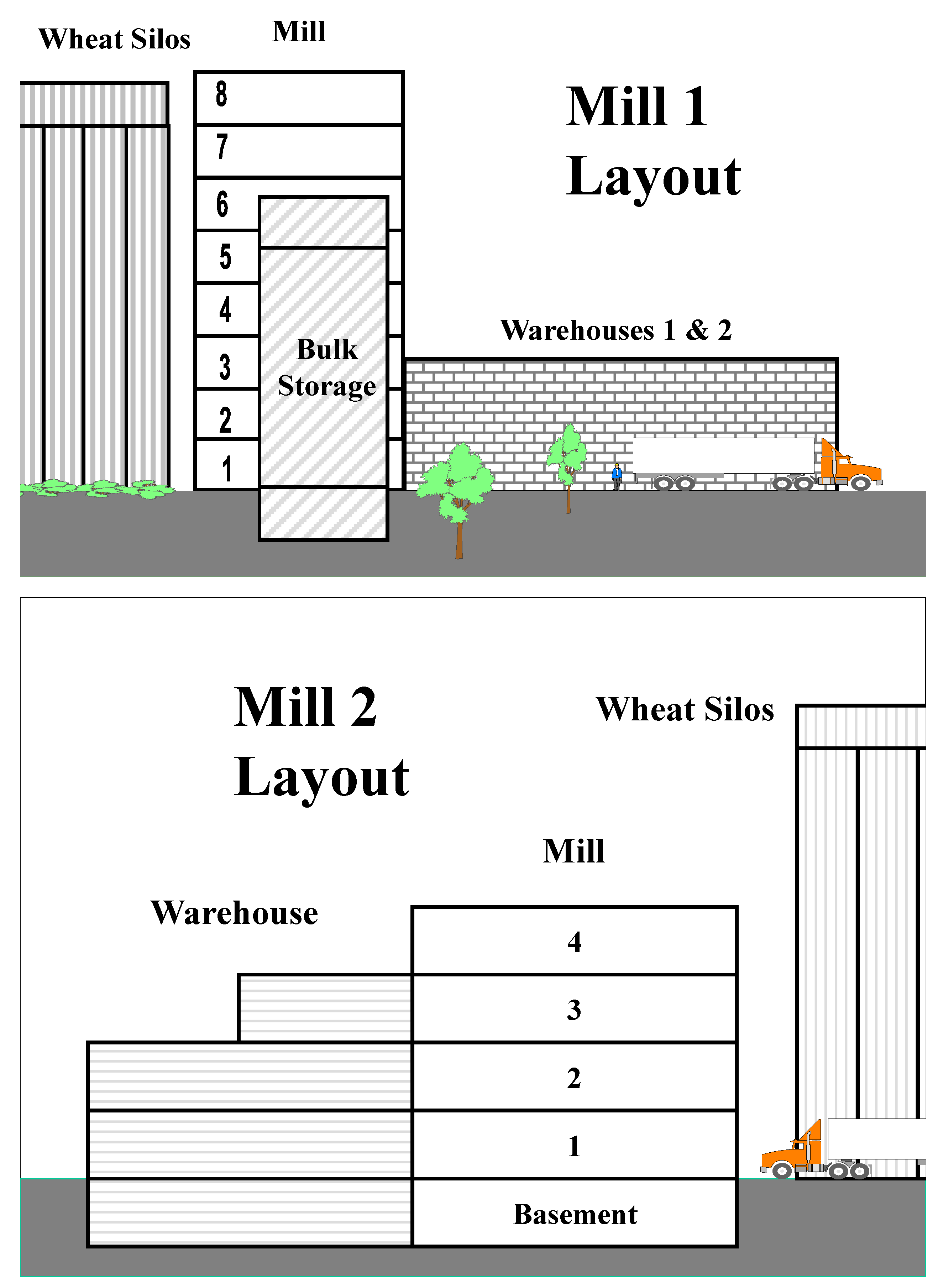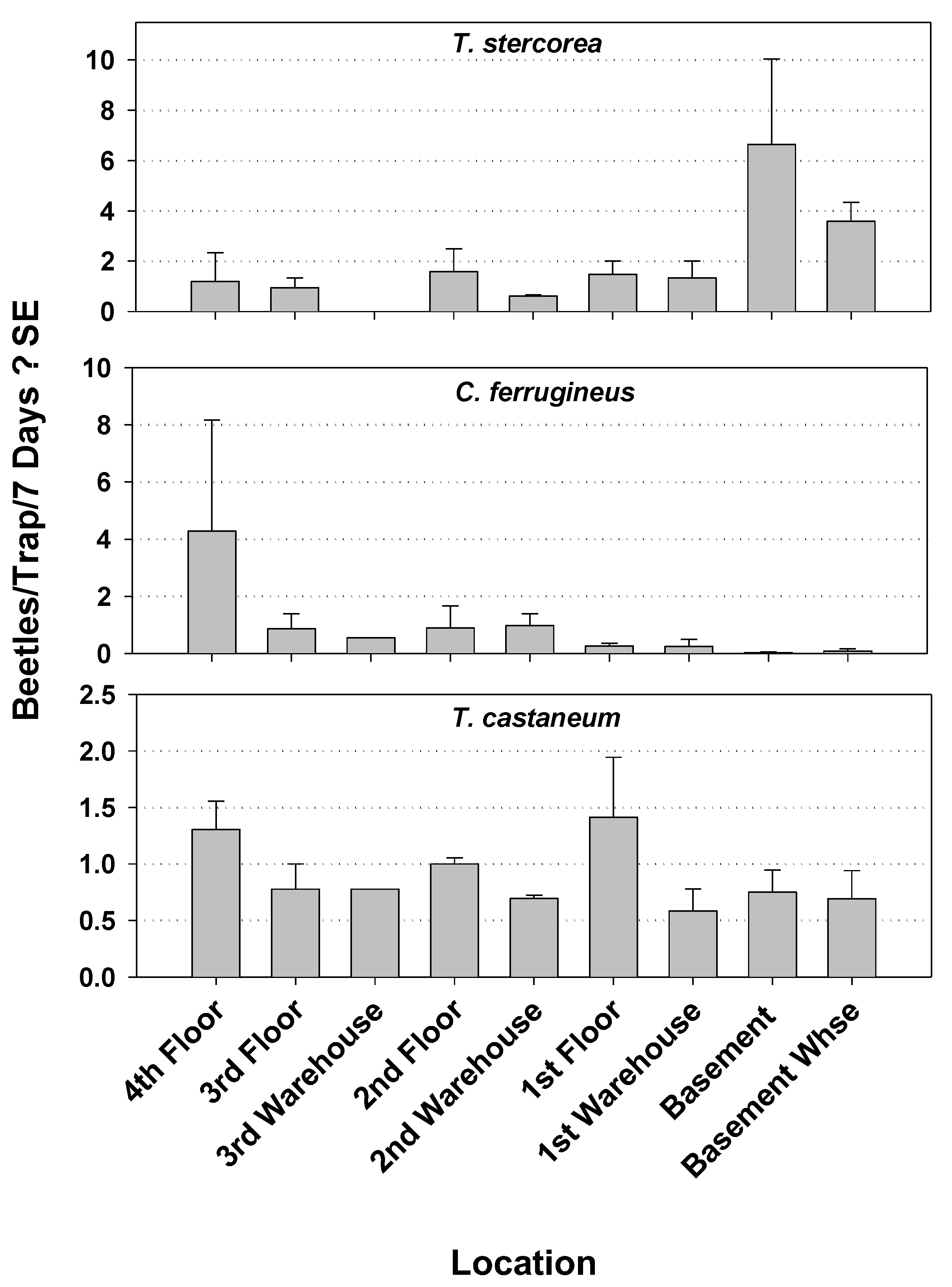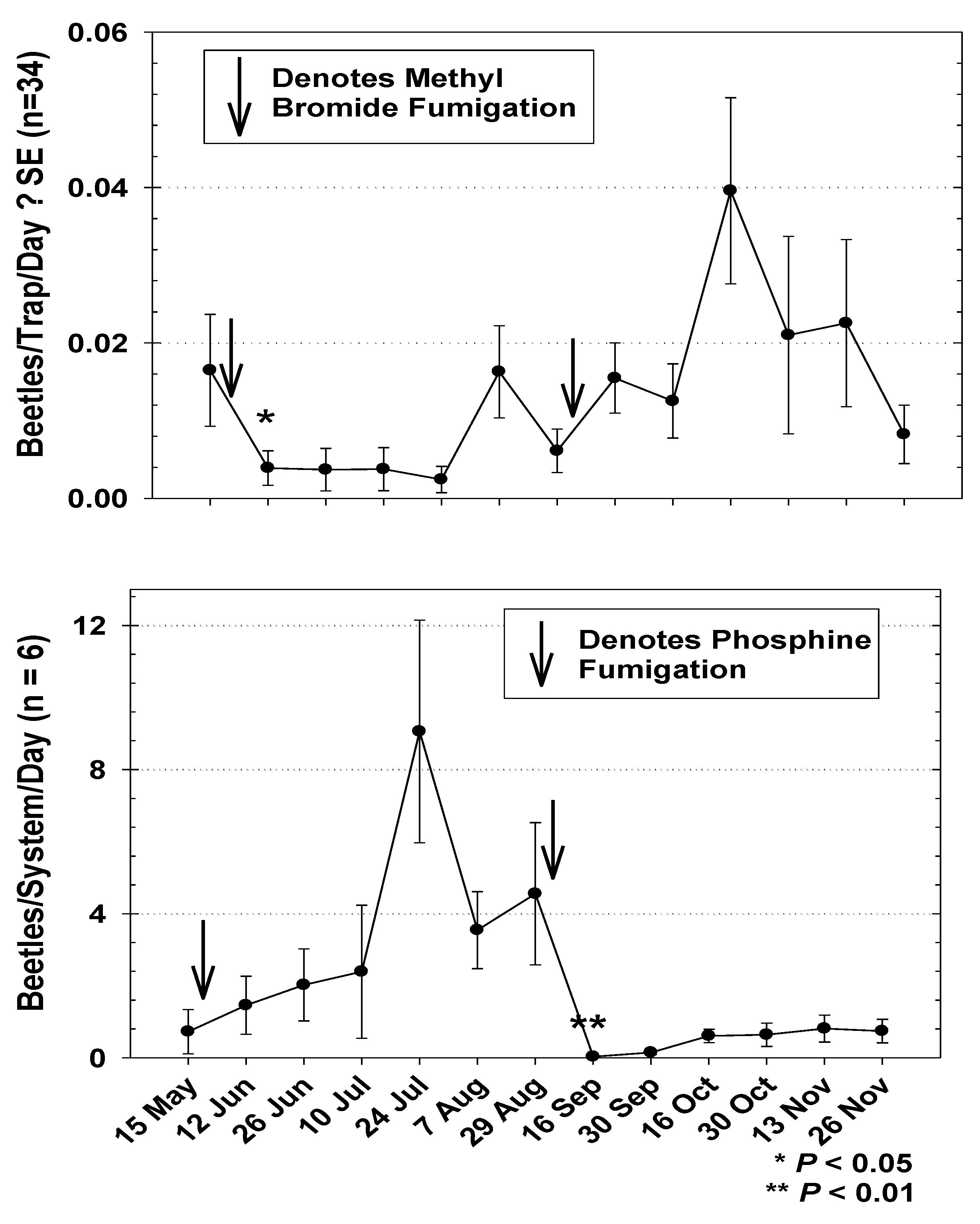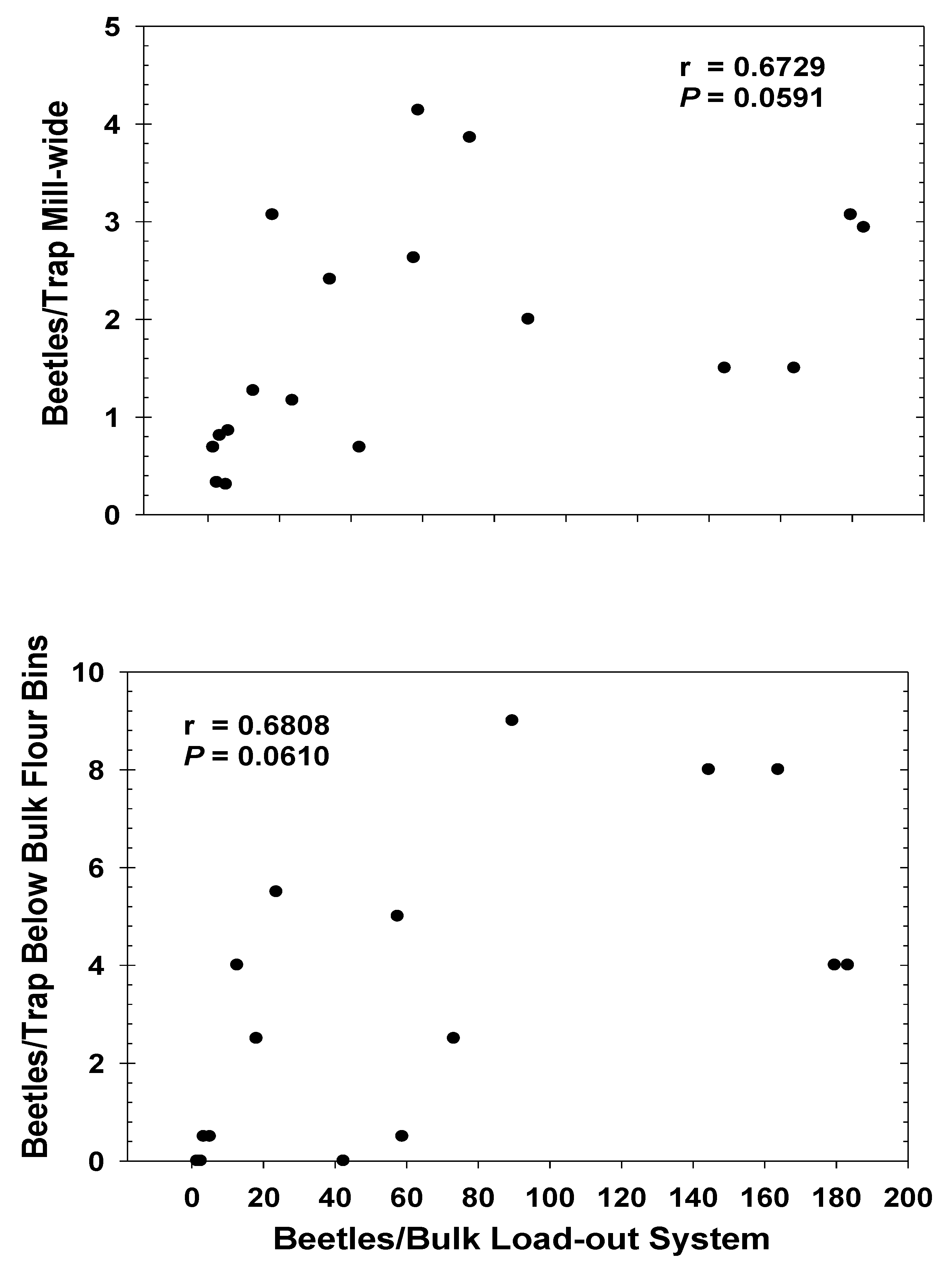1. Introduction
Integrated pest management (IPM) is critical to the food processing industry because government regulations and industry standards mandate minimum insect contamination in food products and minimum residues of chemical pesticides [
1]. Methyl bromide is a compound that was commonly used as a structural fumigant by most flourmills in North America. However, the production and use of methyl bromide was phased out in the USA starting in 2005, after which it was entirely banned under the Clean Air Act for non-quarantine or critical pre-shipment uses because it is an ozone-depleting substance (
https://www.epa.gov/ods-phaseout/methyl-bromide). Since that time other fumigants, or alternatives to fumigation, have been applied to flourmills and other structures to manage stored product pests. Pest management that integrates sanitation, pest monitoring for action thresholds, and targeted controls following informed decisions is one alternative for flourmills. Monitoring pest populations by deploying insect traps over space and time is an important method for collecting data on pests to aid in decision-making with regard to fumigation or continued maintenance.
Tribolium flour beetles (Coleoptera: Tenebrionidae), particularly the red flour beetle,
T. castaneum (Herbst), are considered the predominant pests of the U.S. flour milling industry [
2,
3,
4]. Early work surveyed insect pests in 17 flourmills throughout Missouri, Kansas, and Oklahoma [
4].
Tribolium were found in 78% of all samples taken, and present in 97% of all infested samples. The beetle goes through complete metamorphosis with six larval stages. Both adult and larval stages cause damage by actively feeding on post-harvest commodities [
4]. Trapping to monitor
Tribolium and other mill pests plays an important role within an IPM program [
5], and needs to continue as a standard practice and necessity in IPM for flourmills without methyl bromide fumigation. Stored-product insect trapping methods include the use of pheromone and food-baited traps [
5,
6,
7,
8]. However, despite the extensive research on insect chemical ecology and trap development, limited research has documented the usefulness of traps for detection and monitoring pest populations of
Tribolium and other pests under field conditions, e.g., [
9,
10,
11]. Additionally, the utility of traps as indirect sampling tools for stored product beetles as related directly to product sampling for estimating pest population size needs more research.
Trapping data for stored product insects in food processing systems can be very important for understanding the population dynamics of a target population and can provide information for pest management decision-making [
12]. Such data can help evaluate the efficacy of fumigation or other major pest mitigation efforts. Published literature on
T. castaneum populations before and after fumigation is limited, but some major studies have been reported [
13,
14]. Trapping by itself with species-specific pheromone lures provides good information on the presence or absence of a pest and any variation in the size of a pest population over time and location in a building. Though excellent for detecting and monitoring a pest population, trapping is a relative tool for estimating the size of a population, while direct sampling of a target pest in a commodity or a given physical space provides a direct measurement of a population’s size [
5]. The research reported below gives direct product sampling data for a direct estimate of a
T. castaneum population size, and demonstrates a correlation of trap captures with commodity samples.
The present study was conducted in two commercial flourmills using pheromone traps for
T. castaneum with the following objectives. First, we sought to detect the beetle pest species present and their distribution at the mills across different spaces and over time at regular trapping intervals. Second, to monitor
T. castaneum activity before and after fumigation to assess the efficacy of a facility-wide control treatment. Third, we correlated numbers of
T. castaneum trapped to the numbers of
T. castaneum counted from direct samples of the finished flour product. The work below was first reported in a university thesis by Doud [
15].
3. Results
During the Year 1 study in mill 1, T. castaneum was the species capture the most at 137 trapped, compared to the numbers of other stored product beetles captured. Numbers of other species captured, reported parenthetically here in order of decreasing abundance, included T. stercorea (85), A. advena (Waltl) (53), Sitophilus oryzae (L.) (Coleoptera: Cuculionidae) (19), Oryzaephilus surinamensis (L.) (Coleoptera: Silvanidae) (11), and Cryptolestes ferrugineus (Stephens) (9). During the Year 2 study in mill 1, T. castaneum was again the most abundantly captured beetle pest (494), other species captured, in order of decreasing number, include: T. stercorea (212), O. surinamensis (95), C. ferrugineus (82), and A. advena (74). Capture of all beetles increased during Year 2 in mill 1 over Year 1 captures. In mill 2 (studied in Year 2 only), T. stercorea was the most abundant pest species captured throughout the study (630), followed by C. ferrugineus (383), T. castaneumm (262), Trogoderma spp. (Coleoptera: Dermestidae) (82), O. surinamensis (41), and A. advena (23).
Capture of
T. stercorea was significantly different by location within mill 1during Year 1, being significantly higher in the feed area of warehouse compared to the other areas, which were all similar to each other (
Figure 2). The capture of
T. castaneum and
C. ferrugineus revealed no significant differences by location at mill 1 in Year 1. During Year 2 in mill 1, capture of
T. stercorea was again significantly different by location with the highest capture being within the first floor. The captures of
T. castaneum and
O. surinamensis again were not different among locations in mill 1 (
Figure 3). In mill 2, the capture of
T. castaneum, C. ferrugineus, and
T. stercorea was not different among locations (
Figure 4).
The seasonal capture of
T. castaneum in mill 1during Year 1 was initially lower at the beginning of the study and was highest toward the end, regardless of MB fumigation (
Figure 5). Capture of the beetle was significantly lower following the 31 May MB fumigation, and increased numerically after the 30 August fumigation, though this increase was not significantly over pre-fumigation capture (
t = 1.74; df = 50;
p = 0.0900). Seasonal activity of
T. castaneum from bulk load-out tailing samples of finished flour in mill 1 during Year 1 were generally higher at the beginning of the study (
Figure 5).
T. castaneum sampled from the load-out raised slightly following the 31 May phosphine fumigation, but not significantly higher than pre-fumigation capture (
t = 2.49; df = 5;
p = 0.2434). However, captures were significantly lower following the 30 August fumigation (
Figure 5). The test of the correlation coefficient of
T. castaneum trapping data to data from tailing samples revealed no significant relationship during the Year 1 study (r = 0.3973;
p = 0.1789).
T. castaneum captured in the building was highest during the first week of the Year 2 study in mill 1, and dropped significantly following the 4 July MB fumigation (
Figure 6). Observations of
T. castaneum sampled in flour from bulk load-out tailings during Year 2 also dropped significantly following the 4 July phosphine fumigation (
Figure 6). Beetles in load-out samples remained relatively low until 10 September, followed by a steady increase throughout the remainder of the study. The test for the correlation coefficient comparing the mill 1 Year 2
T. castaneum trapping data throughout the entire mill to beetles sampled from tail-over samples revealed a nearly significant positive correlation (
Figure 7). Correlation of beetle counts from tail-over samples to the mean beetles per trap per day captured only in the room below the area under the bulk product bins was also nearly significant (
Figure 7).
The highest capture of
T. stercorea in mill 2 during Year 2 was observed during the second week of the study and declined over the following three weeks. Capture rose slightly following the 1 August MB fumigation, but not significantly from pre-fumigation capture (
t = 1.58; df = 16;
p = 0.1761) and remained relatively steady throughout the remainder of the study (
Figure 8). Capture of
C. ferrugineus was cyclic for the first five weeks of the study followed by steady lower captures throughout the remainder (
Figure 8). Capture fell immediately preceding MB fumigation and was not significantly different following treatment (
t = 1.81; df = 16,
p = 0.0947). Capture of
T. castaneum was highest during the first week of the study, and decreased significantly following MB fumigation. Following fumigation, weekly beetle capture remained relatively low and steady throughout the remainder of the study.
4. Discussion
Trap catches were lower than expected during the Year 1 study in mill 1, particularly on the mill processing floors, despite evidence of a substantial beetle population observed from visual observations while at the mill. Low capture of
T. castaneum might have been due to low efficiency of the Flit Trak
® M2 traps from the dusty conditions in the mill. Flour dust, particularly abundant among the mill processing floors, can offer a food source to beetle populations and appears to also interfere with the efficacy of traps that rely on sticky or oily surfaces to capture insects [
18]. It was commonly observed that the traps in the warehouse area were still effective after the two-week interval between trap servicing, whereas the trapping oil reservoir of traps in other areas of the mill had been saturated with dust to the point that they could not have killed any insects falling into them. Furthermore, the amount of dust covering the inner sides of the pitfall trap was often sufficient that any trapped insect could have likely crawled out of the trap; further reducing trap efficiency. Evidence of trap interference from dust was observed from a separate study of mill dust accumulation in covered vs. uncovered pitfall traps [
18]. Traps placed in the clean warehouse area in that study experienced little to no increase in weight due to dust, whereas the third floor of the mill experienced the highest dust increase. Earlier studies on stored product moth trapping demonstrated that adhesive traps could be detrimentally affected by dust [
20].
The method of cleaning the various mill areas may have played an important role in trap interference as well. An observation from the earlier dust accumulation study was that traps within some areas of the mill (i.e., the area below the bulk-stored flour bins and the feed area of warehouse 1), unlike the third floor processing area, were adequately protected from dust by the trap dust covers [
18]. This may explain why dusty areas such as the feed area of warehouse 1 and the area below the bulk storage bins experienced relatively high beetle capture compared with the milling floors. The notable difference between these areas (below bulk bins and feed area) and the milling floors is that the feed area and the area below the bulk bins were only cleaned weekly with compressed air blow-downs, whereas the milling floors (floors 3 to 8) were cleaned daily with compressed air. These compressed air blow-downs were likely detrimental to the efficacy of both the pitfall traps. The high pressure air currents created from the blow-down technique can force dust under even the PVC end-cap cover modification used to protect the pitfall trap. The standard cardboard covers for the pitfall traps used during Year 1 likely offered even less protection from this cleaning technique. Therefore, trap efficacy in the mill seemed to be a function both of the amount of dust in the particular mill location, as well as the method and frequency of cleaning within that area. Thus, an accurate estimation of beetle spatial distribution in mill 1 was likely not recorded during either year, although possibly more accurate during Year 2 over Year 1 due to the dust cover modified traps used in the Year 2 study. The suspected lower efficacy of traps used during Year 1 may explain the lack of correlation observed between data from
T. castaneum trap capture and those sampled from bulk load-out tailings. Trap efficiency was likely higher in mill 2 compared with mill 1, as mill 2 did not perform compressed air blow-downs, but rather cleaned with a vacuum system and sweeping. Cleaning done with use of compressed air should include collection of traps before the process to aid trap efficacy.
Capture of T. castaneum in mill 1 was increased during the Year 2 study, perhaps due to factors such as the use of the dome-modified trap. The decreased interval of trap servicing from biweekly to weekly likely played a role in higher tap capture. Many of the traps on the mill floors were likely rendered ineffective after one or two of the daily compressed-air floor cleanings described above. Therefore, more frequent trap servicing would allow more time overall to capture insects before the traps were inundated with dust from cleaning. This idea is further suggested by the fact that all other beetle pests captured during the Year 2 study, with the exception of S. oryzae, increased above Year 1 captures as well. The overall T. castaneum populations may have been higher in the mill during Year 2. Based on the only independent measure of beetle abundance available, namely, the number of beetles sampled from tailings of the bulk load-out, the total number of beetles observed in flour samples for the Year 2 study was 410 (over 30 wk), compared with 1100 (over 20 wk) for the Year 2 study.
Mill 2 was different than mill 1 in relative abundance of beetle pests captured.
T. stercorea was the most abundantly captured pest in mill 2. The location of
T. stercorea capture could be explained by this species’ fungivorous feeding habits [
21,
22], and therefore it is not surprising that this beetle was commonly trapped in the musty basement areas.
C. ferrugineus was the second most abundantly captured beetle in mill 2 and was largely concentrated in space and time to the fourth floor during the first and fourth weeks of the study. These data indicate a “hot spot” of activity, which was apparently temporal, as capture of this beetle was relatively low following the initial peaks of activity.
T. castaneum was the third most abundantly captured species in mill 2. Capture of this beetle both spatially and temporally was less variable than the other two species, which could reflect a steady and relatively more evenly dispersed population throughout the mill compared to the other two species. It is interesting to note that
T. stercorea and
C. ferrugineus were captured more abundantly than
T. castaneum, despite using pheromone-baited traps specifically for
Tribolium. This observation, as well as the low number of
Tribolium sampled from the bulk product, are evidence that
T. castaneum was not as abundant as other pests in this mill. Another difference of mill 2 beetle captured over mill 1 was that a notable amount of
Trogoderma that were captured in mill 2, where they were rarely captured in mill 1 and were not counted there. These differences between the two mills may reflect differences in species diversity of stored-product beetles between the two locations. Similar work using
Tribolium pheromone baited traps in food facilities will frequently trap beetle species other than
Tribolium, suggesting the pheromone is apparently not repellent to some other species, or that there may be attraction of non-
Tribolium species as an adaptive behavior to finding suitable habitat or food [
9,
23].
One striking difference between the two mills was the apparent lack of large beetle populations in mill 2 bulk flour bins compared with mill 1 as evidenced from tail-over flour samples. This can most likely be explained by the high turn-over in mill 2, as each flour bin was emptied twice a day, according to the mill manager. Mill 2 had much less storage capacity than mill 1, furthermore all load-out systems were bulk-loaded into rail cars or trucks, which facilitated fast turn-over of large bulks compared with the flour-bagging systems used in mill 1. Therefore, newly milled flour was cycled through these bins in mill 2, possibly before a beetle infestation of this material could start and subsequently increase.
It should be understood that not every pest species captured in the mill is a direct threat to the product. The hairy fungus beetle,
T. stercorea, are commonly associated with post production food sources, but which feed on fungi primarily rather than directly on the food product. Furthermore, this pest has a large number of setae, which give it its hairy appearance also make it unable to maneuver easily through bulk flour [
22]. This fact, along with the beetles’ preference for fungi, make it a minor economic pest to the mill; however, its presence should be of concern as harboring large populations of any pest insect is undesirable. Presence of these beetles might indicate mold issues in the product/facility and should be further investigated. The rusty grain beetle, C.
ferrugenius, was also commonly captured in mill 2. This species is a small beetle (2 mm), which prefers the germ portion of the wheat kernel [
21]. Because flour does not contain wheat germ, this beetle is more often a pest to whole wheat or intermediate flour products that still contain germ. Nevertheless, regardless of some species not feeding directly on the finished flour product, the presence of any insect or insect fragment found in a food commodity like wheat flour can contribute to actionable levels by regulatory agencies [
24].
Varying effects on
T. castaneum populations by fumigations are indicated according to the particular treatments and methods of sampling. According to the tail-over counts in flour, the 31 May Year 1 phosphine fumigation in mill 1 seemed to have had no effect on the beetle numbers, whereas the beetle counts in flour tail-overs in mill 1 on 30 August decreased significantly following phosphine fumigation and remained low for the following five weeks up to the end of the study. The lack of effect observed from tail-over data following the 31 May phosphine fumigation may be likely due to the fact that many of the bins contained too much flour to be treated effectively, or some beetles or beetle life stages in the bins were resistant to phosphine [
25]. Conversely, the 30 August phosphine fumigation seems to have been effective with a dramatic lowering of the tail-over counts following fumigation. However, trap captures throughout the mill increased approximately fourfold following the 30 August MB treatment in mill 1 (
Figure 5). The 4 July fumigation in mill 1 during Year 2 was followed by significant reductions in both the numbers of beetles sampled from tailings, and beetles trapped (
Figure 6).
Trapping data collected in this study before and after mill-wide fumigations does not fully support the effectiveness of MB in adequately eliminating or controlling
T. castaneum populations. Similar results with
T. castaeum were found in more extensive studies of fumigation in flour mills (Campbell et al. 2000a and 2000b). Trap captures in this current study were not significantly different after MB fumigation in some cases, or if so, the beetle trap counts increased within a few weeks, suggesting either there were living beetles remaining or that new beetles entered the mills and began new infestations. Flourmills are not completely closed systems, so trapping data may have included immigrating beetles from outside through doors and windows following fumigation, and therefore may confound results. Flight of
T. castaneum outdoors has been well-documented [
18,
26] and immigration of beetles from distant sources outside a mill is a real possibility. Better attempts should be made to prevent the possible access of beetles into the mill from outside in order to longer-term efficacy of a fumigation. This is obviously a challenge in a functioning mill where bay doors must be opened to load and ship the product in trucks, shipping containers and rail cars. Nevertheless, fumigation effects were likely reflected by significant reductions in beetle captures following treatment, although captures were never eliminated completely. A recent trapping study with the Indian meal moth
Plodia interpunctella (Hübner) (Lepidoptera: Pyralidae) and the warehouse beetle,
Trogoderma variabile Ballion) Coleoptera: Derestidae), also showed that methyl bromide fumigation did not reduce pest populations down close to zero trapped in several cases [
11].
This research provides data that shows changes in relative population from trap-catch data for T. castaneum can vary similarly with population estimates from absolute sampling of product. Results from Year 2 in mill 1 showed a positive correlation between numbers of T. castaneum caught in traps and those sampled and those sampled directly from bulk flour load-outs at the same times. Both the comparisons of beetles captured mill-wide, as well as that of beetles captured directly below the bulk flour bins were both well-correlated to beetles in flour tailings. The highest numbers of T. castaneum captured per trap occurred in the area below the bulk stored product bins; therefore, the overall summed mill capture was largely made up of captures in those six traps within this area. Furthermore, capture throughout the mill locations was relatively consistent; thus, isolating capture below the bins did not reveal any capture patterns that were not expressed in the overall mill capture.
An important consideration regarding the comparison of trap capture to tailings counts is that although the counts were both taken within the same facility, and enumerated the same beetle species, the bulk stored product bins and various areas of the mill are quite different environments. The bulk stored bins offer a large, relatively undisturbed, and unlimited food source, whereas beetles occurring throughout other areas of the mill (i.e., in machinery, floors, and walls) are likely limited in food supply, shelter, and are more likely to be frequently disturbed from sanitation procedures. These differences, no doubt, affect the beetle population dynamics. However, the trapping data compared to beetles in bulk load-out bins during Year 2 at mill 1 correlated nearly significantly to each other. The beetles counted from bulk load-outs represent a direct sample of the beetles present in that commodity, and the beetles caught in traps represent an indirect sample of beetles in an area that by themselves give information on relative population size differences over time and space [
12]. Similar work with other insects to correlate trap counts with infestation level of a crop or commodity do not always find a close relationship [
5]. The fact that we observed a reasonable correlation of the two data sets points to the value of pheromone traps for
T. castaneum to help estimate the size of the local beetle population and then to contribute to IPM decision-making.













